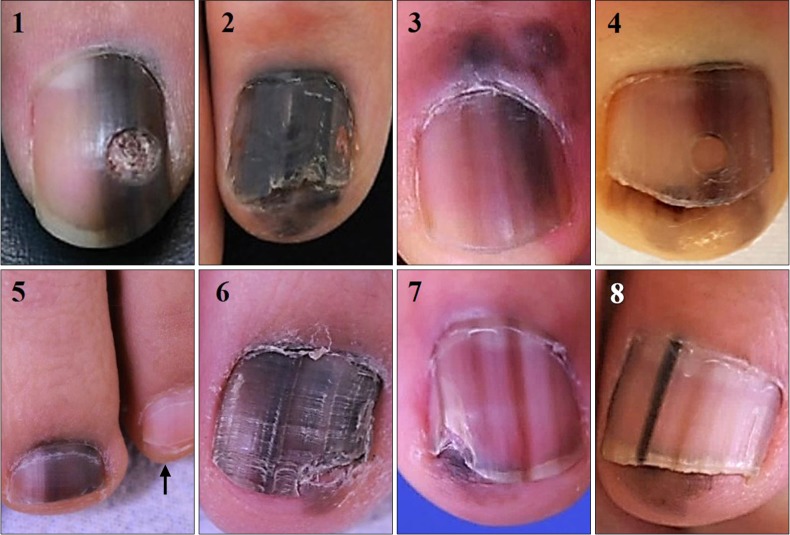Ann Dermatol.
2018 Feb;30(1):36-40. 10.5021/ad.2018.30.1.36.
Early Detection of Subungual Melanoma In Situ: Proposal of ABCD Strategy in Clinical Practice Based on Case Series
- Affiliations
-
- 1Department of Dermatology, Samsung Medical Center, Sungkyunkwan University School of Medicine, Seoul, Korea. dylee@skku.edu
- KMID: 2399752
- DOI: http://doi.org/10.5021/ad.2018.30.1.36
Abstract
- BACKGROUND
Prevalence of subungual melanoma (SUM) in Asian population is relatively high and early clinical detection improves both quality of life and survival.
OBJECTIVE
We sought to establish screening strategy for SUM in situ.
METHODS
We retrospectively reviewed medical records of 8 patients pathologically diagnosed as SUM in situ between January 2015 and September 2016.
RESULTS
All patients in our study were adults and had solitary lesion. In all cases, longitudinal melanonychia as well as background pigmentation in entire nail plate was observed. Seven (87.5%) cases had periungual pigmentation. Clinical features of SUM in situ can be summarized according to new criteria categorized under initial letters of alphabet, namely nail ABCD of SUM in situ; "A" stands for adult age (age >18 years); "B" for brown bands in brown background; "C" for color in periungual skin; "D" for one digit. Our strategy was to suspect SUM in situ if solitary longitudinal melanonychia in adult was satisfying either "B" or "C" in ABCD. All cases were suspected as SUM in situ under nail ABCD rule, and histological examination confirmed diagnosis. Sensitivity and specificity of nail ABCD was 100% and 96.6%, respectively, regarding our previously published 18 SUM in situ and unpublished 28 nail matrix nevi cases as well as 8 SUM in situ presented here.
CONCLUSION
ABCD rule is simple and sensitive clinical strategy for early detection of SUM in situ.
MeSH Terms
Figure
Reference
-
1. High WA, Quirey RA, Guillén DR, Munõz G, Taylor RS. Presentation, histopathologic findings, and clinical outcomes in 7 cases of melanoma in situ of the nail unit. Arch Dermatol. 2004; 140:1102–1106. PMID: 15381551.
Article2. Duarte AF, Correia O, Barros AM, Ventura F, Haneke E. Nail melanoma in situ: clinical, dermoscopic, pathologic clues, and steps for minimally invasive treatment. Dermatol Surg. 2015; 41:59–68. PMID: 25521106.3. Saida T, Ohshima Y. Clinical and histopathologic characteristics of early lesions of subungual malignant melanoma. Cancer. 1989; 63:556–560. PMID: 2912531.
Article4. Park SW, Jang KT, Lee JH, Park JH, Kwon GY, Mun GH, et al. Scattered atypical melanocytes with hyperchromatic nuclei in the nail matrix: diagnostic clue for early subungual melanoma in situ. J Cutan Pathol. 2016; 43:41–52. PMID: 26423820.5. Ishihara Y, Matsumoto K, Kawachi S, Saida T. Detection of early lesions of “ungual” malignant melanoma. Int J Dermatol. 1993; 32:44–47. PMID: 8425802.
Article6. Levit EK, Kagen MH, Scher RK, Grossman M, Altman E. The ABC rule for clinical detection of subungual melanoma. J Am Acad Dermatol. 2000; 42:269–274. PMID: 10642684.7. Richert B, Theunis A, Norrenberg S, André J. Tangential excision of pigmented nail matrix lesions responsible for longitudinal melanonychia: evaluation of the technique on a series of 30 patients. J Am Acad Dermatol. 2013; 69:96–104. PMID: 23453241.
Article8. Di Chiacchio N, Loureiro WR, Michalany NS, Kezam Gabriel FV. Tangential biopsy thickness versus lesion depth in longitudinal melanonychia: a pilot study. Dermatol Res Pract. 2012; 2012:353864. PMID: 22496683.
Article9. Sureda N, Phan A, Poulalhon N, Balme B, Dalle S, Thomas L. Conservative surgical management of subungual (matrix derived) melanoma: report of seven cases and literature review. Br J Dermatol. 2011; 165:852–858. PMID: 21812768.
Article10. Nakamura Y, Ohara K, Kishi A, Teramoto Y, Sato S, Fujisawa Y, et al. Effects of non-amputative wide local excision on the local control and prognosis of in situ and invasive subungual melanoma. J Dermatol. 2015; 42:861–866. PMID: 25982364.11. Shin HT, Jang KT, Mun GH, Lee DY, Lee JB. Histopathological analysis of the progression pattern of subungual melanoma: late tendency of dermal invasion in the nail matrix area. Mod Pathol. 2014; 27:1461–1467. PMID: 24743223.
Article12. Ohn J, Choe YS, Mun JH. Dermoscopic features of nail matrix nevus (NMN) in adults and children: a comparative analysis. J Am Acad Dermatol. 2016; 75:535–540. PMID: 27177439.
Article13. Kim JY, Choi M, Jo SJ, Min HS, Cho KH. Acral lentiginous melanoma: indolent subtype with long radial growth phase. Am J Dermatopathol. 2014; 36:142–147. PMID: 24556899.14. Kemmett D, Ellis J, Spencer MJ, Hunter JA. The Laugier-Hunziker syndrome--a clinical review of six cases. Clin Exp Dermatol. 1990; 15:111–114. PMID: 2347100.
Article15. Lalosevic J, Zivanovic D, Skiljevic D, Medenica L. Laugier-Hunziker syndrome--case report. An Bras Dermatol. 2015; 90(3 Suppl 1):223–225. PMID: 26312723.16. Valero A, Sherf K. Pigmented nails in peutz-jeghers syndrome. Am J Gastroenterol. 1965; 43:56–58. PMID: 14252603.


